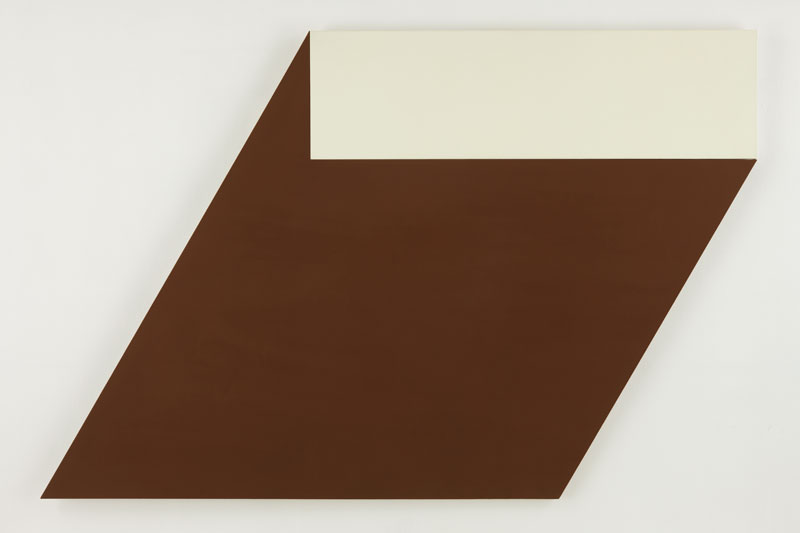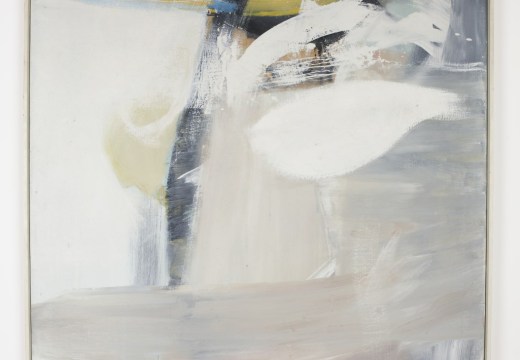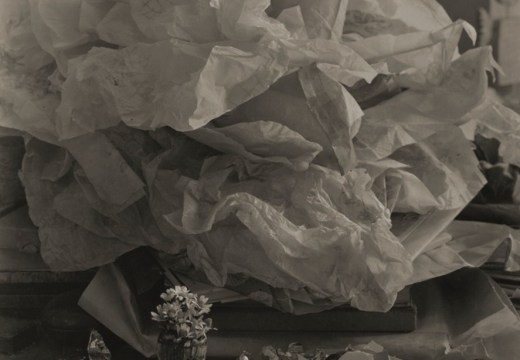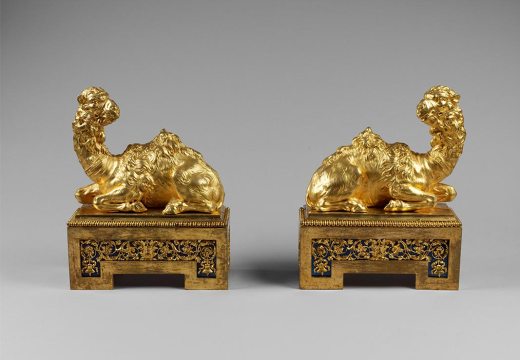The American artist Ellsworth Kelly has died at his home in Spencertown, N.Y., at the age of 92. Kelly was one of the greats of American abstract art, with a distinctive sense of geometry and colour that marked him out from his peers. He was highly influential in the emergence of Minimalism and Pop Art in the US, but had learnt from the European abstract tradition in post-war Paris – and it was France that he spoke memorably about to Louise Nicholson, when she interviewed him for Apollo in October 2013, shortly after his 90th birthday. Below, we reproduce that interview in full as a tribute to the artist.
***
Tea, coffee, champagne?’ is Ellsworth Kelly’s greeting. As it was his 90th birthday on 31 May, continuing the celebration seems legitimate. But it is 10.30am on a hot, harshly lit August day in the rolling wooded hills of the Hudson Valley, two hours’ train ride north of New York. We are on the terrace outside Kelly’s studio and offices at Spencer town. A Kelly sculpture is mounted on each side wall; Kelly totems and tall pine trees define the deep perspective of the lawns ahead of us. I suggest we have tea now, champagne later. He chuckles, calls out to his staff for cushions and we settle ourselves into wicker chairs, beneath an umbrella.
While museums up and down the East Coast of the US have celebrated the nonagenarian with shows, I’ve come to seek out personal memories that he believes have defined his artistic journey, one that William Rubin described as ‘inner-directed: neither a reaction to Abstract Expressionism nor the outcome of a dialogue with his contemporaries’.
‘Remembering I can’t get rid of,’ says Kelly. And, despite the inconvenience of a plastic tube feeding him oxygen (the consequence of decades of working with turpentine), he embarks upon eloquent ‘Remembering’ until we are called to lunch hours later.
‘Living in France began it all. I’m a real Francophile.’ His first visit was inauspicious, moving through Brittany and Normandy to Paris in 1944, in a camouflage unit. ‘We were supposed to lure the Germans into our situation and then get out so the forces could come in.’ Kelly arrived in war-torn Paris just after the celebrations. ‘There were no cars, just bicycles, and people came up to us because they knew we had candy and cigarettes.’ Things might have improved when a close army friend returned from dinner to say he’d met Picasso. ‘He was called Griswold, a rich boy from an old family in Connecticut. He met Picasso at Gertrude Stein’s. I said I’d like to meet him but Griswold said: “Oh no, you’re just a country boy.” ‘ Kelly had to be content with Griswold’s reports. ‘Griswold looked like a Picasso blue period figure, and Picasso did draw him. I expect you’d like to see it.’ He calls to Eva, his archivist, to bring down the 1944 volume of the Zervos catalogue raisonné of Picasso. She arrives with it in seconds, and together they find the portrait. Kelly also drew Griswold. ‘It’s good to know you drew the same model as Picasso. When I went to study at Boston, I’d say: “Oh, I’ve seen Picasso.” That’s the main lie in my life – that I got away with,’ he laughs. ‘It made me popular. I was a shy kid.’
Back in the US, he took advantage of the government’s GI Bill, a package of incentives for US war veterans that included education and training. ‘It was fantastic,’ he says emphatically. ‘They should have it now. It removed anxiety; I was able to experiment. I thought: I’ll go to Boston and learn about drawing the nude, painting the nude.’
He did just that, enrolling at the School of the Museum of Fine Arts in 1946. ‘Boston was very backward, not like New York City where abstract art was beginning.’ Above all, he learned to draw and has drawn throughout his life, in particular plants and their leaves. ‘Leaves are planar, if you see what I mean. Most of my paintings are about planes.’ He calls Eva to bring him several catalogues including a Betty Parsons show of 1963. ‘All painting is about overlapping flat planes. Now, here,’ he says pointing to a painting, ‘is Blue on Blue, playing around with relief. The eye does the work. My recent paintings take this further.’ He opens a more recent catalogue. ‘See how the yellow overlaps the red. In all Renaissance painting there is overlap. I call it a lie – yes, it’s a trick, a better word,’ he says with a glint in his eye. He was pleased when the Metropolitan Museum of Art did a show in 1970 about New York painters and sculptors, and curator Henry Geldzahler ‘chose Jasper, Claus and me for drawings. We’re all natural drawers. He gave me a whole room of plant drawings.’ The Met repeated the honour in 2012 with a one-man show of his plant drawings.
One Boston teacher knew Max Beckmann and invited him to lecture on Cézanne in 1948. The combination inspired Kelly to hasten back to Paris that year, changing his US-dollar grant on the black market to stretch it further.
Post-war Paris worked well for Kelly and he lived there for six years. ‘I love the measure of France, the measure of the architecture, how it’s built, the measure of the countryside, the villages. I was fascinated. I drew a lot.’ He was also intrigued by the Paris art world. ‘I was excited by Matisse, Derain and of course Picasso. The post-war School of Paris artists fascinated me, but I didn’t like the geometric developments.’ He also ‘needed to get Picasso off my back. All the artists had to do this. He’d reigned in Europe for such a long time. So I stopped painting for a while but kept drawing. I think all my work begins with drawing, including portraits, which I’ve never shown.’
There was almost no information on American art in Paris. ‘One day, at Brentano’s bookstore on the avenue de l’Opéra, which occasionally had foreign magazines, I spotted a picture on the cover of Art News. It was by Ad Reinhardt.’ It made him decide to return to New York. When he asked his parents for the $200 fare home and $200 more to ship his art, his mother sent him $200 with instructions to leave the art. ‘So I went to Cunard, asked if I could pay my fare later and they let me. I thought my paintings were too important to use to pay for my fare. I know some artists do that.’ Indeed, Kelly has numbered and catalogued his work throughout his life.
In Manhattan he lived at the southeastern tip of the island. ‘I worked on Broad Street, one big room with a terrace overlooking the East River. Coenties Slip was the next block, and in ’56 I moved there. The loft was $45 a month, and had two floors; the top one with a skylight was my studio. Agnes Martin sometimes shared the studio. Jasper Johns and Bob Rauschenberg were up the street. Roy Lichtenstein was my closest artist friend. That was a good time.’ Betty Parsons was his dealer. ‘[She] took me straight away. Believed in my colour. In 1970 I went across the hallway to Sidney Janis who was always interested in what I was doing. He had the top artists: Pollock, De Kooning, Rothko, Barnett Newman, Clyfford Still.’ Kelly pauses reflectively. ‘They weren’t selling much. There wasn’t a big market for contemporary art then.’
In recalling this period of his life, Kelly addresses his artistic dilemma: being part of both European and American post-war art worlds when they were so radically different. ‘On my return to America, I felt that my art had been influenced by the early 20th-century European artists, rather than the Abstract Expressionist art that was happening in New York before and during the length of my stay in Paris. I did feel for a number of years that my art was different than what was happening in New York. I remember when some of my work was exhibited in Europe during the 1960s, I felt a more favourable response, especially from London, and was accepted more easily than in New York.’ Kelly believes specifically that his art ‘is something that I began in 1949 in Paris [when he made his first abstract paintings] and that the main qualities of my work have continued to develop until the present. I have never considered myself exclusively an American artist, just an artist.’
But ‘just an artist’ with a strong French twist. As he cherry picks his memories, time and time again France is at the root of what follows. For instance, colour. ‘There is a difference between European colour and American colour. America misunderstood my colour; [they] thought it was out of date, but in fact it was different. It was Matisse, Derain, the Fauves, Mondrian; how Kandinsky began as a figure painter and changed to Cubism around 1910.’ But he was not immediately successful. He showed some of the colourful paintings he’d done in the South of France, where he’d wintered in 1951 and ‘felt I’d done something important. But when they were shown in New York, people didn’t catch on because it looked strange. They thought I was 30 years late.’ He pauses. ‘Abstract American art was very designy. I wasn’t.’ Nevertheless, the Museum of Modern Art included Kelly in its landmark 1959 show, ‘Sixteen Americans’, and it would give him a retrospective in 1973.
He is reminded of his own colour spectrum that starts and ends with yellow, ‘each colour at its full strength. I don’t like the timid, modish colours found in America.’ As proof he refers to his bold, 14-painting Chatham Series made in 1971, reunited this year at MoMA, as ‘a movement of colour’.
But Kelly has sometimes stepped away from colour. After he moved to Leo Castelli’s gallery in 1973, he did three grey shows (1975, 1975 and 1977). ‘It frees you up. But of course none of them sold,’ he says with a laugh. ‘It was at the height of Vietnam. I stopped colour. I was embarrassed by it.’ He looks out across the lawns and points to a totem sculpture. ‘There’s one over there.’ However, his current dealer Matthew Marks has sold some. ‘Time changes, the work has time to evolve.’
France, too, was the birthplace of Kelly’s fragmentation works. Again, he calls for a book and Eva whisks it to our table. He finds a black and white illustration. ‘This is 1950. I saw the light reflected in the Seine at night, the fragmentation. I wanted to make a painting that catches that fragmentation.’ He did this mathematically on squared paper, starting at either side to give each column one more colour than the last up to the middle, selecting the colours by randomly pulling pieces of coloured paper from a cup. ‘The result is both extremely structured and random,’ he says. ‘I guess I got that from the Surrealists, drawing with eyes closed. Drawing not looking at the page.’
The most magnificent of Kelly’s fragmentation pieces is Sculpture for a Large Wall, made in New York in 1956–57, and owned by MoMA. ‘I call this the sum of what I accomplished in Europe.’ This summer it was exhibited at Philadelphia’s Barnes Foundation. ‘It has to be precisely lit from the top. And it is.’ Eva produces the catalogue, but I’d also seen it in situ at the museum. The top lighting ensures the horizontal tubes holding the shapes are barely visible while the shapes themselves catch the light and seem to be tumbling and dancing.
Part of the continuous draw back to France was Picasso. ‘You have to get over him, but he’s always magnetic.’ On one trip, he hoped to meet him at Vallauris and Mougins. ‘Françoise came to the door and said “No way.'” Even today, he feels the master’s inspiration. ‘When I look at a Picasso I want to paint. He makes painting so delicious.’ Kelly’s eyes sparkle at the thought. ‘He’s a master of composition and solves problems. He’s a genius.’ He seeks for a reason. ‘I think it’s the Spanish in him. There’s Velázquez, Goya, Gaudi, too.’
It is also to France that Kelly traces his interest in relief and, with it, the development of his distinctive curve. ‘It all started there, seeing Egyptian, Romanesque and Byzantine art.’ He calls for another book, and opens it to show an Egyptian relief. ‘This is one of the most important pieces I saw,’ he says firmly, and then becomes almost elegiac. ‘This relates to what I am doing even now. It’s about the continuation of influences, desires. I’m really a visualist fascinated by nature. Look at nature, how it changes, slowly, over time – time is so important to art. I can go back and see things that were so important to me at the beginning, and still are. Europe has tradition and old buildings. I feel a lack of it here – it’s all new and new and new. I think of permanence.’
He reckons his interest in curves came from Romanesque arches. ‘The arch has its own measure. At Royan, in south-west France, I was using free curves, elliptical not radial. Then in 19591 started doing sculptures with radial curves.’ He points to the totems on the lawn. ‘See the white totem? [It’s] a masculine concave form, Apollo, as opposed to the Venus with two convex curves.’ Closer to home, after years of responding to New York’s verticality and compression, Kelly lives among open space, wide horizons, low houses. A piece he’s working on now reflects this. ‘I was driving through a village and noticed all the houses with pitched roofs. It’s always a mystery to me how the idea appears. I can see a symbol and think “That’s it!” I love the mystery.’
The move in 1970 from New York up into the Hudson Valley’s bucolic countryside – with a studio first at Chatham, then at Spencertown – was really no surprise. ‘At Coenties Slip, I looked over wide-open water with boats; the high buildings were behind me. Then, when I moved uptown it was necessary to be near Central Park.’ He lived at Hotel des Artistes on West 67th Street, on the ninth floor. But his paintings were big. To move them out of the studio ‘I had to balance myself and a picture on top of the elevator cab, holding on to the greasy cables’. Here, in his 20,000 square foot studio built in 2001, Kelly can go big with no problem. ‘I like a certain scale, 20–40 feet. From a distance they carry.’ He attributes his penchant for size to Paris visits to the Louvre. ‘When I saw The Wedding Feast at Cana and The Raft of the Medusa, I thought “Aren’t those marvellous?” And everything from ancient times was large. I wanted to fill walls. But I lived in small rooms, so I used to do things in panels.’
Then he adds modestly: ‘Now that I am older, my shoulder can give me trouble. I can’t paint much bigger than seven foot.’ He has two assistants to stretch canvases, order paints, and do other studio work. ‘One assistant is with me when I paint because my eyesight is not as good as it used to be, especially with white on white. So, he is at my elbow telling me what I’m missing. But I do the painting. It makes me feel good, I get exhilarated.’ Kelly has just reminded himself that there is an urgency to paint. And Eva has given us a third reminder that it is lunchtime.
This interview was first published in the October 2013 issue of Apollo.
Louise Nicholson is a freelance journalist and art historian.
Unlimited access from just $16 every 3 months
Subscribe to get unlimited and exclusive access to the top art stories, interviews and exhibition reviews.














![Masterpiece [Re]discovery 2022. Photo: Ben Fisher Photography, courtesy of Masterpiece London](http://www.apollo-magazine.com/wp-content/uploads/2022/07/MPL2022_4263.jpg)
Why are fathers so absent from art history?